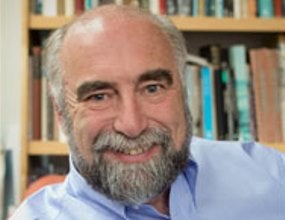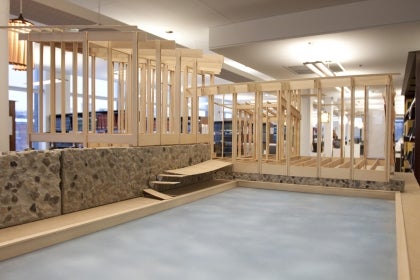
“It’s an amazing coincidence that the first lecture we ever gave in Rome was September 7, 1979, and the first class that occurred in Cambridge was held on September 7, 2004,” he says.

and father, who were prominent Toronto architects. But while they both attended the University of Toronto, he came to Waterloo and graduated with a BArch in 1975. Before the ink on his degree was dry, Haldenby was asked to fill in for an ailing professor and teach a couple of courses.
hen the term was up, he left to bike around Europe after deciding teaching wasn't for him. But his colleagues thought otherwise. While on his cycling trip, he received a telegram in Athens asking him to apply for one of three new School of Architecture positions. He found someone to type his CV, mailed it off, and six months later picked up a telegram from an American Express Office with a job offer. He returned to campus in the fall of 1976 as a junior professor and became the school’s director on January 1, 1988.
Robert Jan van Pelt, a Waterloo architecture professor, says Haldenby is always on the outlook for “the next best thing.”
And
along
the
way
there
have
been
many
of
those
“next
best
things.”
While
still
a
junior
professor,
Haldenby
launched
the Rome
program and
was
the
lead
negotiator
for
Canadian
schools
of
architecture
on
the
establishment
of
a
national
program
of
accreditation
that
provided
the
basis
for
the
integration
of
the
Canadian
architectural
profession
in
North
America,
and
the
world
at
large.
A
Remarkable
Legacy

“As a student you are absolutely mesmerized by his words,” says Lacalamita of Haldenby who teaches iconography theme courses at the school. “His power of storytelling is something that sticks with you.”
The recipient of the university’s Distinguished Teacher Award, he’s also been involved in archeological work in Italy, Carthage and Malta and runs a mid-size city research program.
Along with the November 30 event, Haldenby’s exceptional impact on the school and its students is being marked by two scholarships, including an undergraduate scholarship in his name. Tickets to the celebration of Haldenby’s 25 years as director of the school are still available and donations to the scholarship are welcomed.
Haldenby officially steps down as director at the end of December and will be succeeded by Ila Berman, who joined the school in September 2013. But rather than taking a break, Haldenby has a long list of plans that includes continuing his research and teaching in Rome where, along with founding the school’s Rome program, he married his wife Rosemary and their two sons, Adrian and Julian, were baptized. He will also be renovating the Palladian cottage his grandfather built on Rice Lake’s Spook Island.
Building is what Lacalamita says Haldenby’s legacy is about.